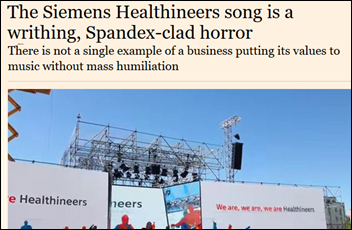
GE Healthcare announced this morning at its Centricity Live 2016 user conference in Phoenix, AZ its next-generation IT solution for ambulatory care delivery. I spoke with GE Healthcare IT VP/GM Jon Zimmerman of the company’s value-based care solutions team ahead of the announcement.
Describe Project Northstar that is being announced.
Project Northstar is GE Healthcare’s next-generation IT solution for ambulatory care delivery to fundamentally help practices thrive in the world of value-based care. We strongly believe that the move to value-based care is on. It’s not going to be a light switch. It will be a transition over time.
We also see that the tools and services that have been built around population health have not been integrated with care delivery from a community perspective. It’s certainly not completely integrated with revenue cycle management with both value and volume in mind. Payers are changing, too, so there’s new payer connectivity required.
We’re taking a point of view from a physician’s workflow and driving population health integrated with care delivery, integrated with revenue-cycle management both value and volume, with new forms of payer connectivity to take waste out of the system. Our drive is to increase quality, efficiency, and financial performance for customers.
Is this a standalone product or is it just for Centricity users? Who is the target customer?
The audience starts with GE Centricity Practice Solutions / GE Centricity EMR first, but we built it with open principles. We believe that some of the advanced ACOs may want to take some of the capabilities that we’re offering and also make them useful and integrated on top of other EMRs.
Is it an upgrade or a separate product that Centricity customers will buy?
Look at it as an extension from what people have today with a migration path to roll it over Centricity over the next few years. We believe that a big-bang replacement would be a very bad and disruptive idea. Many of our customers have given us great clues on how to do a safe, smart migration transition. It’s not a big bang, turn that off, turn that on.
What providers and partners did you work with?
We worked with Westmed Practice Partners in Westchester, NY starting almost two years ago. One of the things that was highly attractive about working with Westmed is that they were scoring very high in their quality measures. Their efficiency measures and their ability to collect revenue from their fee- and value-based contracts were also very good. Their leadership knew what they were doing. They knew how they did it.
They were pushing our products up to and beyond their capabilities in order to make that happen. When I thought about how we were going to get to that next generation and who we could work with, I thought it would be good to start with somebody who was so very skilled and who knew us so well. That was Westmed Practice Partners, specifically Dr. Simeon Schwartz, the chairman and CEO.
Was the product built from scratch?
It is not being built from scratch, nor is it being acquired. This was a big discussion that Simeon and I had in the beginning. We are building certain components. We’re also assembling capabilities from different technology providers across the industry.
I don’t think anybody is going to be able to have the time to just go build from scratch, but taking a modern, 21st-century approach is going to be key. We have the luxury of leveraging is a lot of the investments that GE is making with Health Cloud, so this is an extension of what GE is doing as well.
It seems that you’re picturing an ecosystem with components provided by partners. How will that look?
First and foremost, we took a tabula rasa approach, meaning a blank slate. Once we got comfortable with one another in Westmed – and other practices have also helped us design this — one of the keys was, how do you guys work? What do you do all day? We went even to the depths of, with appropriate permissions,observing their delivery of care.
We broke it down with a number of usability experts. GE Corporate, GE Digital has been investing in usability expertise and usability engineers. We leveraged those to break down the work processes of a pretty complex multi-specialty practice. We also focused strongly on, as you would imagine, that primary care is the quarterback, and that user experience is a big deal.
On the business side, we said, how does that work? How can we make a system provide more value for the providers? We broke the providers’ work into basically four areas.
Number one is that I need to understand. When I’m going to see a patient, I need to know a lot about them. How should a system gather that information for me?
Once it gathers that information, I need to know what I’m supposed to do. I need to know how to work. Underneath that is a rules engine that we’ve selected. The rules will be based on what the clinicians want to do. We’ll get rules from specialty societies or individual practices and combinations thereof. They will create a rules-driven system that’s based on a modern user experience with workflow guidance to then get the providers to do what the providers know that they need to do. Our approach here will remove clicks, but also provide consistency through the guidance of the decision-makers for that practice.
The next piece of work is that I need to review and sign. Rules comes in and say, did I do all the things that I’m supposed to do that will be impactful for my volume-driven revenue cycle? Did I document what’s required for my quality reporting?
Last but certainly not least, there’s follow-up care coordination and care management that creates a continuous loop in the system versus a set of independent acts.
For the user experience, we’re using the same technology that Google uses. That’s called AngularJS. For the rules engine, we’ve purchased a commercial rules engine and we’ve put that into our stack. To fill the rules engine, we’re working with a number of practices, with Dr. Schwartz being the first. We have another one signed up specifically for cardiology. We have a workflow engine. Our cloud provider is technologies from GE Health Cloud and supplemented by some things we’ve been doing with Microsoft and Azure over the last few years.
You mentioned reduced clicks and the user experience. You’re not replacing the UI of Centricity, correct?
We had a lot of robust dialogue with our customers on this. The first and greatest impact that we can have is the process of creating intelligent orders — orders that take the context of the patient, the context of the payer, and the context of evidence-based practice and build them into one.
In our initial implementation, users will be in Centricity up to the point where it’s time to create an order. Then the new system takes over seamlessly. It pulls all the information that customers are used to in Centricity. Now you’re into the cloud experience, the next-generation system. Once you complete that set of tasks, we bring you back into the world that you live in.
Physicians spend an awful lot of their time, as they should, in workflows for ordering and diagnosing. That’s why we did that. The more that we talk with customers, they said, "You made absolutely the right choice."
How are you using payer information?
I was one of the lucky people who got to work as a pioneer to invent what we know today as the EDI systems of the US for healthcare starting back in the late 1980s. I have a long-term relationship with working between payers and providers. Just before I came to GE, I was lucky enough to work with a great company called Availity, a provider / payer network owned by 21 Blue Crosses and Humana. I got the opportunity to understand a lot of the payer processes and what’s missing in the bridge between payers and providers that creates an awful lot of wasted work.
GE was an inaugural investor in the AHIP Innovation Laboratory. AHIP, the payers’ professional association, knew that they had to create more innovation because of the trends that we see. We are inaugural investors.
We are reverse engineering the exchanges of information between payers and providers that goes through phone calls, faxes, physical mail, and portals and embedding that into our current and next-generation systems. A very important point: this is not going to have to wait for a next generation. We’re doing that now.
Let me give you a couple of examples. In Medicare Advantage, being able to prove as a payer that you are closing gaps in care and that patients are getting good care requires that if the payers see that things are not happening at differential analysis, then we can take a gap in care directly from a payers’ system. Some are pushing them out through sidecars and eligibility transactions. We put that information into the providers’ workflow so the know what’s necessary to be done. Then the providers can use their normal processes to get the work done and deliver the care.
Then payers are going to want it reported back. They’ll take it through a claim, or some are asking for CCDAs to be sent to them. We also are building the capabilities to deliver the clinical care documents, then the summaries with details, back to the payers so they can ingest them into their various systems, not their claim systems.
Another example is the need for hierarchical condition categories for risk adjustment. We can construct the appropriate data sets that payers are constantly calling the providers for and we can deliver it to them electronically. We know this because we work directly with payers and providers in their distinct workflows to be able to build these new bridges, to do it as electronically as possible within the workflows to reduce burden, reduce waste, and deliver on the Triple Aim.
What’s the timeline for delivering the product?
The first wave is going to come out in Q1 ’17. We’re working with our user groups and providers directly. There’s that preparatory. Then the orders module will come out first, followed by more enhancements that we’re going to be delivering in the RCM, followed by more and more clinical documentation and a collaboration. We’re also simultaneously building a lot more interoperability for collaboration among providers.
Everything that we’re doing from a workflow and technology perspective is being supported by a cloud-based interoperability collaboration hub and supported by analytics that are integrated as well, because there’s going to be a lot of adjustments over time.
We see this complete picture rolling out over the next three years. Based on demand and based on the number of ecosystem partners that we see, we hope to be able to accelerate that, but we want to first and foremost do no harm and create a lot of value as people have to change their business models during this very dynamic time, like none other that we’ve seen before in this industry.


















































































In my experience, it’s extremely hard to get heath systems to care about this stuff. It requires a level of…